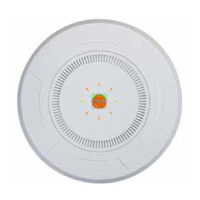Wireless Access Point
528
Intrusion Detection is enabled or disabled separately from monitoring. See Step 1
in “Intrusion Detection” on page 372.
Radio Assurance
The AP is capable of performing continuous, comprehensive tests on its radios to
assure that they are operating properly. Testing is enabled using the Radio
Assurance Mode setting (see “Advanced RF Settings” on page 357). When this
mode is enabled, the monitor radio performs loopback tests on the AP. Radio
Assurance Mode requires Intrusion Detection to be set to Standard (See Step 1 in
“Intrusion Detection” on page 372).
When Radio Assurance Mode is enabled:
1. The AP keeps track of whether or not it hears beacons and probe
responses from the AP’s radios.
2. After 10 minutes (roughly 60 passes on a particular channel by the
monitor radio), if it has not heard beacons or probe responses from one of
the AP’s radios it issues an alert in the Syslog. If repair is allowed (see
“Radio Assurance Options” on page 529), the AP will reset and
reprogram that particular radio at the Physical Layer (PHY — Layer 1).
This action takes under 100ms and stations are not deauthenticated, thus
users should not be impacted.
3. After another 10 minutes (roughly another 60 passes), if the monitor still
has not heard beacons or probe responses from the malfunctioning radio
it will again issue an alert in the Syslog. If repair is allowed, the AP will
reset and reprogram the MAC (the lower sublayer of the Data Link Layer)
and then all of the PHYs. This is a global action that affects all radios. This
action takes roughly 300ms and stations are not deauthenticated, thus
users should not be impacted.
4. After another 10 minutes, if the monitor still has not heard beacons or
probe responses from that radio, it will again syslog the issue. If reboot is
allowed (see “Radio Assurance Options” on page 529), the AP will
schedule a reboot. This reboot will occur at one of the following times,
whichever occurs first:

